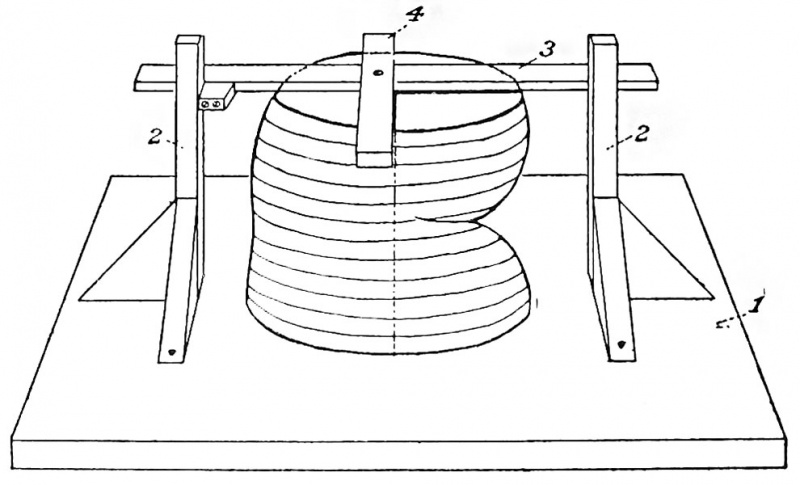File:Mall Meyer1921 fig04.jpg

Original file (990 × 600 pixels, file size: 70 KB, MIME type: image/jpeg)
Fig. 4. Method of making guide lines
- baseboard
- perpendicular posts
- straight edge
- piece at right angles to it.
Lewis (1915) and is known as the Lewis guide liner (fig. 4). After the guide-lines have been drawn on each wax plate they are transferred to the photographs or drawings. This is done by superposing each wax plate upon its photograph or drawing and marking the end of the guide-lines. When the wax plate is removed, these points are connected by lines similar to those on the plates. After the two principal guide-lines have been established, it has been found convenient to use secondary guide-lines, 5 cm. apart, which run parallel to the primary ones over the entire surface of the photograph.
| Embryology - 16 Apr 2024 |
|---|
| Google Translate - select your language from the list shown below (this will open a new external page) |
|
العربية | català | 中文 | 中國傳統的 | français | Deutsche | עִברִית | हिंदी | bahasa Indonesia | italiano | 日本語 | 한국어 | မြန်မာ | Pilipino | Polskie | português | ਪੰਜਾਬੀ ਦੇ | Română | русский | Español | Swahili | Svensk | ไทย | Türkçe | اردو | ייִדיש | Tiếng Việt These external translations are automated and may not be accurate. (More? About Translations) |
Mall FP. and Meyer AW. Studies on abortuses: a survey of pathologic ova in the Carnegie Embryological Collection. (1921) Contrib. Embryol., Carnegie Inst. Wash. Publ. 275, 12: 1-364.
- In this historic 1921 pathology paper, figures and plates of abnormal embryos are not suitable for young students.
1921 Carnegie Collection - Abnormal: Preface | 1 Collection origin | 2 Care and utilization | 3 Classification | 4 Pathologic analysis | 5 Size | 6 Sex incidence | 7 Localized anomalies | 8 Hydatiform uterine | 9 Hydatiform tubal | Chapter 10 Alleged superfetation | 11 Ovarian Pregnancy | 12 Lysis and resorption | 13 Postmortem intrauterine | 14 Hofbauer cells | 15 Villi | 16 Villous nodules | 17 Syphilitic changes | 18 Aspects | Bibliography | Figures | Contribution No.56 | Contributions Series | Embryology History
| Historic Disclaimer - information about historic embryology pages |
|---|
| Pages where the terms "Historic" (textbooks, papers, people, recommendations) appear on this site, and sections within pages where this disclaimer appears, indicate that the content and scientific understanding are specific to the time of publication. This means that while some scientific descriptions are still accurate, the terminology and interpretation of the developmental mechanisms reflect the understanding at the time of original publication and those of the preceding periods, these terms, interpretations and recommendations may not reflect our current scientific understanding. (More? Embryology History | Historic Embryology Papers) |
File history
Click on a date/time to view the file as it appeared at that time.
| Date/Time | Thumbnail | Dimensions | User | Comment | |
|---|---|---|---|---|---|
| current | 21:45, 29 March 2017 |  | 990 × 600 (70 KB) | Z8600021 (talk | contribs) | |
| 23:51, 19 November 2012 |  | 993 × 685 (95 KB) | Z8600021 (talk | contribs) | ==Fig. 4. Method of making guide lines== # baseboard # perpendicular posts # straight edge # piece at right angles to it. Lewis (1915) and is known as the Lewis guide liner (fig. 4). After the guide-lines have been drawn on each wax plate they are trans |
You cannot overwrite this file.
